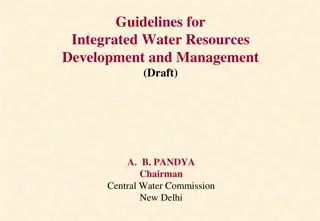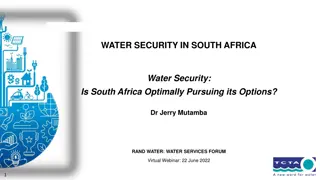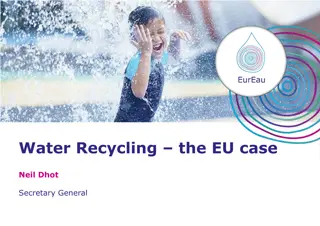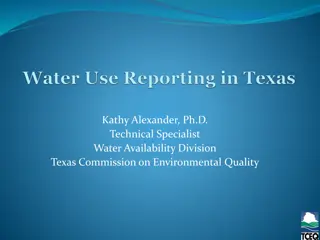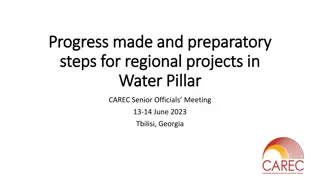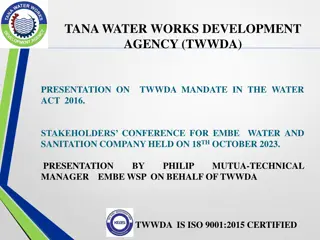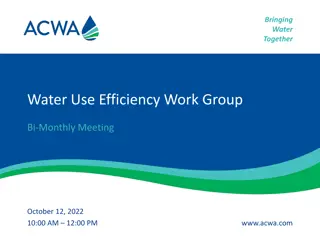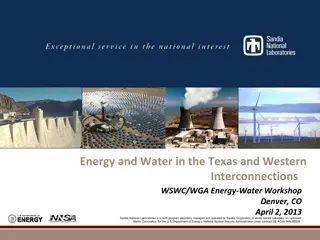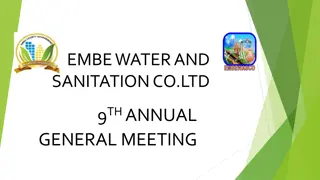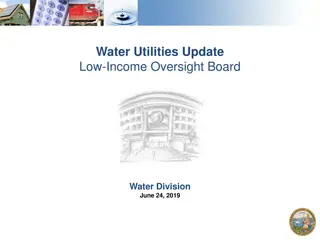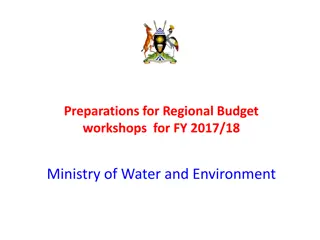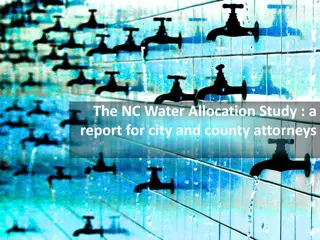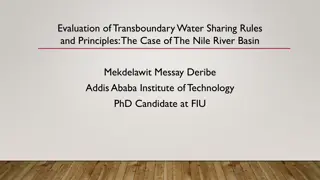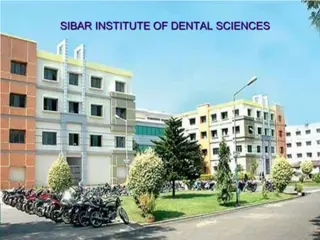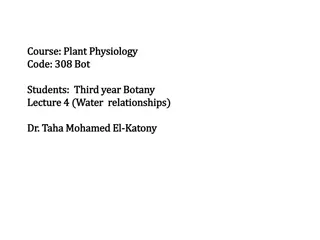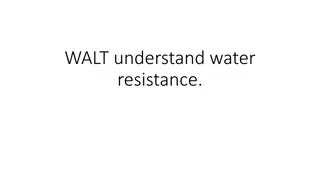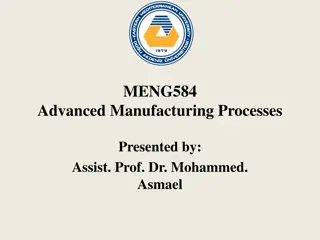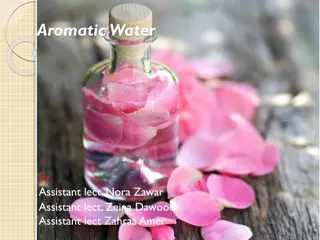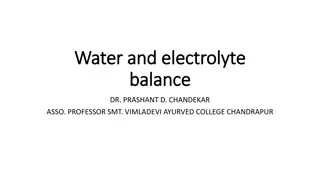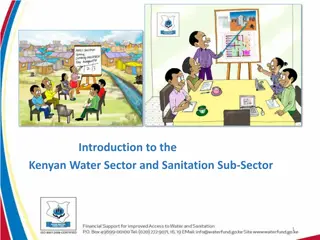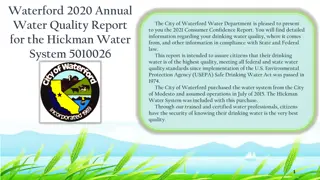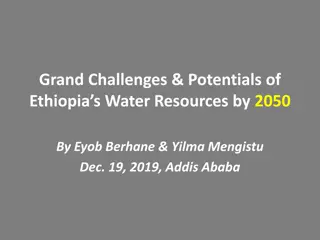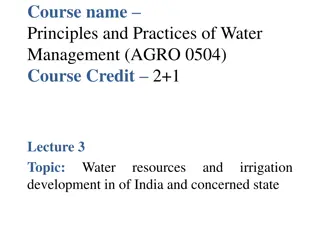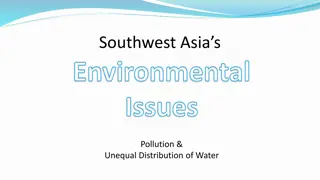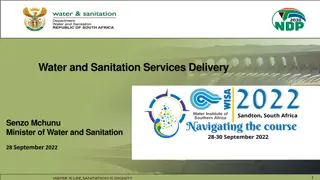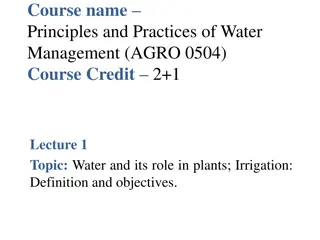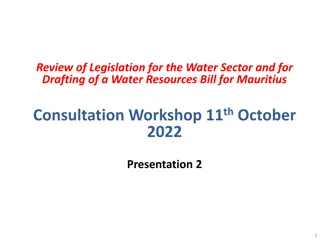Challenges in Managing Water Resources in India
Water scarcity and inefficient water use pose significant challenges in India, with decreasing per capita water availability and a lack of proper infrastructure leading to gaps in irrigation potential utilization. Factors such as poor storage capacity, uneven water distribution, and low water use efficiency further exacerbate the issue.
Download Presentation

Please find below an Image/Link to download the presentation.
The content on the website is provided AS IS for your information and personal use only. It may not be sold, licensed, or shared on other websites without obtaining consent from the author. Download presentation by click this link. If you encounter any issues during the download, it is possible that the publisher has removed the file from their server.
E N D
Presentation Transcript
CADWM Programme and Present Day Challenges Avinash Mishra Jt. Adviser (WR & LR) NITI Aayog 13.03.2018
Water Scenario in India Reducing per capita water availability 6000 Per capita water availability in m3 /year 5177 Water stress 1700 m3/capita/year 5000 4000 Water scarcity 1000 m3/capita/year 3000 2209 1820 1545 2000 1341 1140 1000 0 1981 2021 2041 1991 2011 2031 1951 1961 2051 2061 1971 2001 41865 50000 40000 21764 30000 20000 9802 8153 3343 2346 2060 1545 1396 10000 0
Water Use Scenario in Country Low Water use Efficiency in every aspect of water use i.e. Irrigation, Industries , domestic i.e. 30 to 38% in Irrgn.35 to 45 % Distribution losses in water supply, Industries consuming 3to 6 times more than Global average Poor Storage possibility in the Country i.e. only 262 m3/capita as compared to 1964m3 /capitain USA, 1112 m3 /capita in China, 753.65 m3 /capita in South Africa. Uneven distribution of water in Time and Space. 75-80% run-off in four months (June to September) 59% of available water resources in Ganga- Brahmaputra-Barak water basin Insufficient storage capacity at present: only 253.4 BCM out of total 690 BCM utilizable surface water whereas
Irrigation Potential: Facts at a Glance Ultimate Irrigation Potential of Country 139.43 Million Ha Irrigation Potential Created (IPC) 112.53 Million Ha Irrigation Potential Utilized (IPU) 89.26 Million Ha Gap between IPC & IPU 23.27 Million Ha As per the Planning Commission definition the irrigation water made available up to the outlet of minors (minor canals) will be treated as the Irrigation Potential Created.
Sector wise Irrigation Potential creation and Utilization Factors Sprinkler Irrigation System Drip Irrigati on Surface Irrigati on Overall irrigation efficiency 50-60% 80-90% 30-35% Application efficiency 70-80% 90% 60-70% Water saving 30% 60-70% NA
Reason for IPC-IPU Gap The lack of CAD works below the outlet Resulting into free flooding of farms Leading to over irrigation Dilapidated structures, poor maintenance of canal distributaries and minors. Change in cropping patterns from designed cropping pattern based on agro-climatic condition The projects are constructed on 75% dependability i.e. water in the reservoirs will be adequate in three out of four years. Water Use Efficiency - low in India at 38% comparing with 45% in Malaysia and Morocco, 50-60% in Israel, Japan, China and Taiwan.
Reasons for IPC-IPU Gap contd Presently the gap is 23 Million Ha which indicates that it has resulted into non-utilisation of investment made on creating 23 Million Ha which is at the average of Rs. 4.5 Lakh/ha resulting into Rs. 1.03 Million crore of blocked investment. Development of irrigation projects are constrained because of the issues related to environmental clearances, Land Acquisition and Rehabilitation and Resettlement. The need of the hour is to achieve the full utilization of irrigation potential which is already created. Formation of WUAs will have socio-equitable distribution of water. The Irrigation efficiency like application of micro irrigation method and conveyance efficiency will be positively impacted as a result of the formation of WUAs.
Introduction of CAD CAD programme was initially started in the Ministry of Agriculture in 1974-75 and was transferred to Ministry of Water Resources in the early eighties. The programme has been modified from time to time as per requirements felt during its implementation. Reclamation of waterlogged areas was added as a component w.e.f. 01.04.1996. CAD Programme was restructured as Command Area Development and Water Management (CADWM) Programme w.e.f. 01.04.2004. The scheme was being implemented as a State Sector Scheme during the XIFive Year Plan (2008-09 to 2011-12). The programme is being implemented pari-passu with Accelerated Irrigation Benefits Programme (AIBP) during XII Plan.
Objective : CADWM programme for development of adequate delivery system of irrigation water up to farmers field with an objective to bridge the gap between potential created and utilised and to enhance water use efficiency and production and productivity of crops per unit of land and water for improving socio-economic condition of farmers. The programme envisages integration of all activities relating to irrigated agriculture in a coordinated manner with multi-disciplinary team under a Command Area Development Authority
Components under CAD Programme OFD Works (comprising construction of field channels, land leveling where necessary) also micro-irrigation, Reclamation of Waterlogged Areas (surface & sub-surface drainage) Correction of System Deficiencies in canals between outlet upto 4.25 cumecs (150 cusec) capacity Participatory Irrigation Management (PIM)-One time functional grants and One time infrastructure grant to Water Users Associations One time infrastructure grant to WALMIs/IMTIs Training of Functionaries of CADAs and Farmers Adaptive Trials and Demonstrations (including on micro-irrigation, land leveling, water use efficiency) on farmers field for promotion of improved practices Monitoring and Evaluation Establishment- limited to 10% of the works carried out for OFD Works, Field Drains, Reclamation of Water Logged Area & Correction of System Deficiency.
Pradhan Mantri Krishi Sinchayee Yojana (PMKSY) PMKSY has been approved with an indicative outlay of Rs.50000 crore over a period of five years from 2015-16 to 2019-20 . Further in july 2016 PMKSY mission established to complete 99 Priority Projects including CAD Component. to ensure access to some means of protective irrigation to all agricultural farms (Har Khet Ko Pani) in the country, to produce per drop more crop , thus bringing much desired rural prosperity. The programme is an amalgamation of on-going schemes of Ministry of Water Resources, River Development and Ganga Rejuvenation, Ministry of Agriculture & Cooperation and Ministry of Rural Development.
PMKSY - Convergence PMKSY will also seek convergence of Mahatma Gandhi National Rural Employment Guarantee Scheme (MGNRES), Rashtriya Krishi Vikas Yojana (RKVY), Jawaharlal Nehru National Solar Mission and Rural Electrification programmes (JLNNSM&REP), Rural Infrastructure development Fund (RIDF), Member of Parliament Local Area Development Scheme (MPLAD), Member of Legislative Assembly Local Area Development Scheme (MPLALAD), Local body funds (LBF), Working Plan of State Forest Department (WPSFD) etc.





